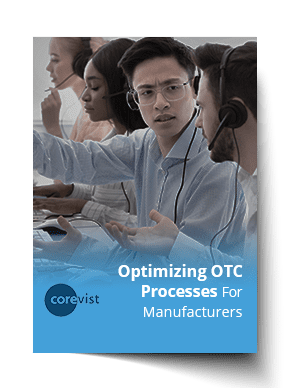Share
Author
George Anderson
Share
Driving efficiency in your Sales reps’ processes
For many manufacturers, legacy order entry methods leave something to be desired. This is true for customers and Sales reps alike. If both customers and reps have to call Customer Service to place orders, then there’s friction in the process, and your cost to serve may be higher than necessary.
If you have waste in your OTC cycle, how do you start reducing it?
Here are two strategies to address “low hanging fruit” in OTC optimization.
1. Replace manual quote generation processes with self-service
For many manufacturers, the quoting process is quite complex.
A customer may go through multiple rounds of communication with a sales rep, and the rep may need to gather large amounts of information on the state of the supply chain to give the customer an accurate quote.
NEW Report:
Optimizing OTC Processes for Manufacturers
Every manufacturer needs to become more efficient. Here’s the ultimate guide to optimizing your OTC cycle. Read now.
While you may not be able to eliminate this underlying complexity, you can simplify the way customers interact with it.
If your quoting process is governed by data and business rules in SAP ERP (e.g. ATP calculations, scaled/personalized pricing, RDD dates, and more), you can make it easier for customers to request quotes. The key is to launch a digital portal solution that supports quote requests—and enforces all personalized SAP ERP business rules which govern the transaction for each unique customer.
This is the thinking behind Corevist Commerce. The solution supports self-service RFQ workflows which conform to your existing SAP business rules.
2. Give Sales reps a portal for order entry
For many manufacturers, Sales reps are an essential part of the OTC process. This is especially true in markets which depend on in-person selling. For many manufacturers, Field Sales reps are the lifeblood of their business.
But the order entry process for Sales reps often has inefficiencies built into it.
If you don’t have a digital order entry portal, your reps will have to call Customer Service to log orders in SAP. Alternately, reps can enter those orders themselves when they get back to the office—but neither workflow is particularly efficient. Each one boils down to “order entry, line by line, via human intermediary.” When that’s the case, there’s always a more efficient way.
A Field Sales Portal is a web-based digital portal which your reps can use from any device. Ideally, it should deliver key functionality through full integration to SAP ERP—things like:
- 100% accurate customer assignment. These relationships live in SAP, so your Field Sales Portal should honor them from SAP with no extra work required.
- 100% accurate inventory, pricing, & more by customer. If your Sales reps are going to build orders in the portal, those orders should conform 100% to the personalized SAP business rules for the assigned customer.
- 100% accurate real-time account standing. Your reps need visibility into credit status, order status & history, invoice status & history, and more. The Field Sales Portal should provide all this information, for each assigned account, straight from SAP ERP.
With a Field Sales Portal in place, you can eliminate the costly back-and-forth of Sales reps calling Customer Service, which eats up paid time for two workers. This is a great place to push for greater efficiency in your OTC cycle.
The Takeaway
A field sales portal for your reps helps reduce unnecessary cost in your OTC cycle. When you give your reps a portal for personalized customer catalogs, order entry, and account status/history, you reduce friction in your reps’ processes, which empowers them to focus on consultative selling and increasing customer value. The result is a lower cost to serve, better customer experience, and bigger sales.
NEW Report:
Optimizing OTC Processes for Manufacturers
Every manufacturer needs to become more efficient. Here’s the ultimate guide to optimizing your OTC cycle. Read now.










